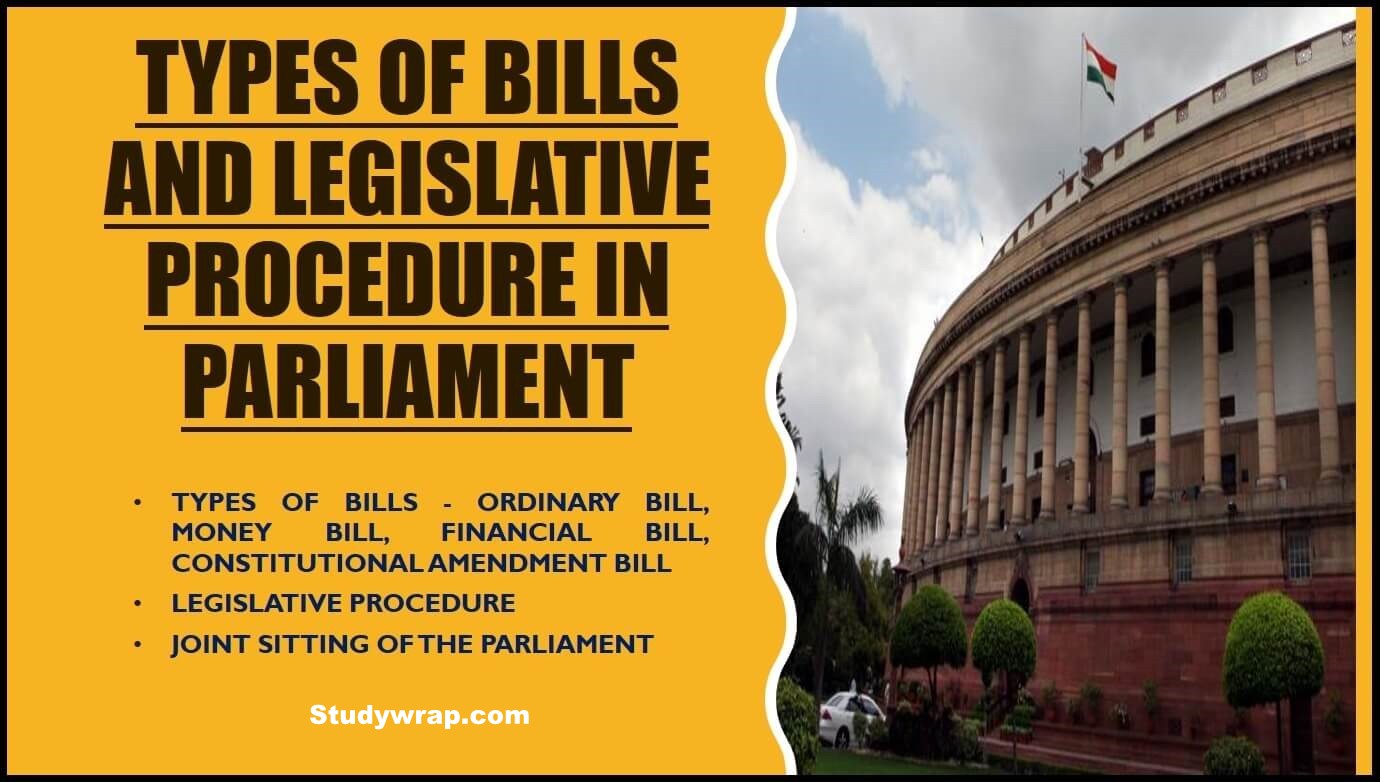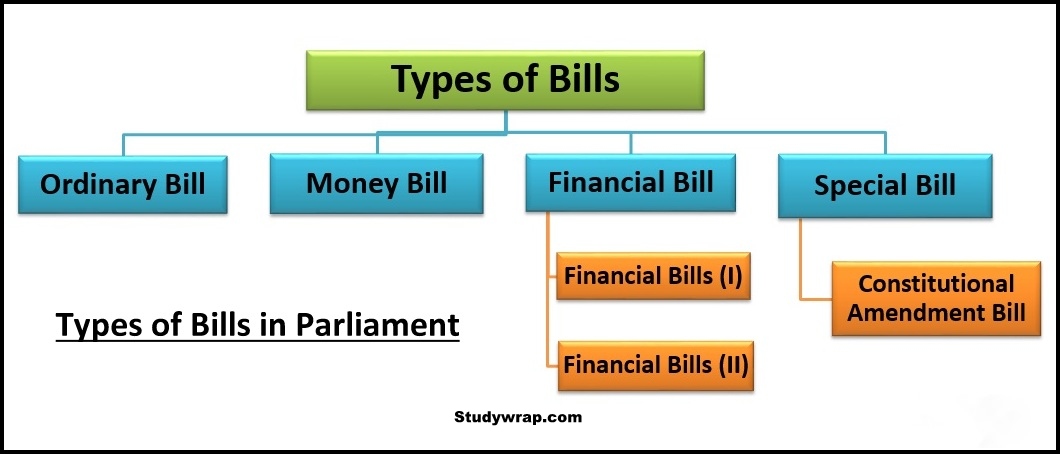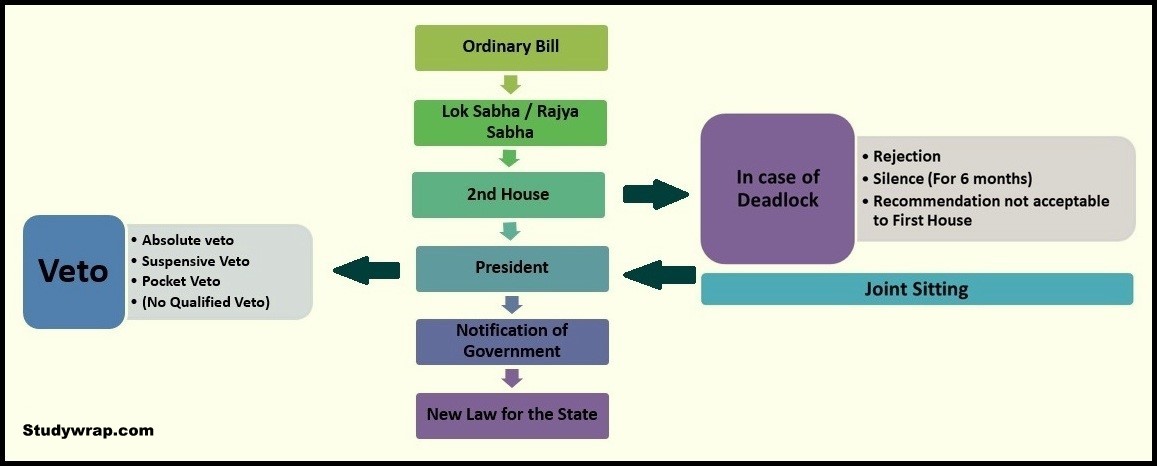Polity
Types of Bills in Parliament and their Legislative Procedure
The Parliament – Types of Bills in Parliament and their Legislative Procedure
Table of Contents
- (Article 79 to 122 of Part V)
- Parliament is the legislative organ of the Union Government.
- Since, India has a Parliamentary system, hence Parliament occupies the central Position.
- Indian Parliament has three broad parts, namely – The President, Lok Sabha and Rajya Sabha.
Legislative Procedure in Parliament
- The Legislative Procedure for both the Houses are same i.e. every bill has to be passed from both the houses to become a law or act.
- Legislative procedure is initiated in the form of a bill, when the Bill is passed by both Houses of Parliament and assented by the President, it becomes a law.
- Bills introduced in Parliament are of 2 types –
-
- Public Bill
- Private Bill
-
Classification of Bills or Types of Bills in Parliament
- The Types of Bills in Parliament which cab be introduced, can also be classified into four categories –
- Ordinary bills – concerned with any matter other than financial subjects.
- Money bills – concerned with financial matters like taxation, public expenditure, etc.
- Financial bills – concerned with financial matters (but are different from money bills).
- Constitution amendment bills – concerned with the amendment of the provisions of the Constitution.
1. Ordinary Bills
- Ordinary bills are concerned with any matter other than Financial Bills, money Bills and Constitutional Amendment Bills.
- Such Bills can be introduced in either House of Indian Parliament without the recommendations of President of India.
- Passed by Simple Majority in both Houses.
- Article 107, 108 deals with Ordinary Bill.
- If there is any deadlock over the Ordinary Bill, it can be resolved by Joint Sitting of both Houses of Parliament.
Procedure for Passing of Ordinary Bills
-
-
-
First Reading
-
-
-
-
- The procedure of legislature to pass a bill starts with introduction of the bill in either house of the Parliament.
- A Bill can be introduced either by a Minister or by a private member.
- Member who introduces the bill asks for the Leave of the House.
- If the motion for leave to introduce a Bill is opposed, the Speaker may according to his discretion, allow brief explanatory statement to be made by the member who opposes the motion and the member-in-charge who moved the motion.
- After House grants the Leave, the introducing member reads its title and objectives. No discussion takes place on the bill.
-
Publication in Gazette
-
-
-
-
- Later, the bill is published in the Gazette of India.
- If a bill is published in the Gazette before its introduction, leave of the House to introduce the bill is not necessary.
-
-
-
-
-
-
Second Reading
-
-
-
-
- This is most important stage on the enactment of the bill.
- In this stage, the bill is scrutinized and attains its final structure.
- This stage can be divided into following –
- Stage of General Discussion –
-
- Printed copies of the bill is distributed in the house. Discussion on Principles and Provisions of the bill takes place, but detailed discussion does not takes place.
- The house on discretion, can take following actions –
- It may take the bill into consideration immediately or on some other fixed date
- It may refer the bill to a select committee of the House
- It may refer the bill to a joint committee of the two Houses
- It may circulate the bill to elicit public opinion
-
- Committee Stage
-
- The bill is referred to Select Committee or Joint Committee.
- Select committee consists of members of the house where the bill has its origin and Joint Committee consists of members from both the House.
- The Committee examines the bill in detail. It can amend its provisions, but without altering its principles.
- After completing the scrutiny and discussion, the committee reports the bill back to the House.
-
- Consideration Stage
-
- The House now discusses the bill in detail, clause by clause which is discussed and voted separately.
- Members can also suggest amendments which upon acceptance of the house becomes part of the bill.
-
- Stage of General Discussion –
-
-
-
-
Third Reading
-
-
-
-
-
- At this stage the debate is limited to arguments either in support or rejection of the Bill without referring to the details and no amendments are allowed.
- If the majority of members present and voting accepts the bill, bill is regarded passed by the house.
- The bill is authenticated by the Presiding officer of the House and transmitted to other house for consideration and approval.
-
-
-
-
-
Bill in the other House
-
-
-
-
-
- After the Bill is passed by one House, it is sent to the other House for discussion and passes through all the three stages, i.e., First Reading, Second Reading, and Third Reading.
- There are four alternatives before this House –
-
- It may pass the bill as sent by the first house (i.e., without amendments).
- It may pass the bill with amendments and return it to the first House for reconsideration.
- It may reject the bill altogether.
- It may not take any action and thus keep the bill pending.
-
- If the Second House passes the bill with without amendments, or the first house accepts the amendments than the bill is deemed to be passed and is sent for President Assent.
- If the Second House rejects the bill, or the First House do not accepts the Amendments as suggested by second house or the Second House do not take any action on the bill for 6 months, a deadlock takes place.
- To solve such deadlock President can summons a Joint Sitting of the Two Houses.
-
-
-
-
Assent of the President
-
-
-
-
- After the bill is passed from both the Houses, it is sent to President’s Assent.
- President has three options for the approval of the bill –
-
- he may give his assent to the bill
- he may withhold his assent to the bill
- he may return the bill for reconsideration of the Houses.
-
- If the president gives his assent to the bill, the bill becomes an act and is placed on the Statute Book.
- If the President withholds his assent to the bill, it ends and does not become an act.
- If the President returns the bill for reconsideration and if it is passed by both the Houses again with or without amendments and presented to the President for his assent, the president must give his assent to the bill.
-
-
2. Money Bills
- Article 110 of Indian Constitution defines another Types of Bills in Parliament i.e. Money Bills.
- These Bills deal with the taxes, borrowings, consolidated and contingency funds, audit and accounting, etc.
- Any bills dealing with any matter of following is deemed to be a money bill, if –
-
- Imposition, abolition, remission, alteration or regulation of any tax
- Regulation of the borrowing of money by the Union government
- Custody of the Consolidated Fund of India or the contingency fund of India, the payment of moneys into or the withdrawal of money from any such fund
- Appropriation of money out of the Consolidated Fund of India
- Declaration of any expenditure charged on the Consolidated Fund of India or increasing the amount of any such expenditure
- Receipt of money on account of the Consolidated Fund of India or the public account of India or the custody or issue of such money, or the audit of the accounts of the Union or of a state
- Any matter incidental to any of the matters specified above
-
- A bill is not considered a money bill if the bill only provides for –
-
- Imposition of fines or other pecuniary penalties
- Demand or payment of fees for licenses or fees for services rendered
- Imposition, abolition, remission, alteration or regulation of any tax by any local authority or body for local purposes
- Article 109 of Indian Constitution gives special procedure regarding Money Bills.
- The decision of the Speaker of the Lok Sabha is final on the question whether bill is a Money Bill or not.
-
Procedure for Passing of Money Bills
-
-
- A money Bill can originate only in Lok Sabha after the recommendations of the President.
- Every Money bill is a Government bill and can be introduced by Minister only.
- After passing of the Bill from Lok Sabha, it is transmitted to Rajya Sabha for consideration.
- Rajya Sabha cannot amend or reject the bill and must return the bill to Lok Sabha within 14 days, with or without recommendations.
- The Lok Sabha can choose to accept or reject any or all of the recommendations of the Rajya Sabha with regard to a Money Bill. The bill is deemed to be passed by both the Houses.
- If the Rajya Sabha does not return the bill to the Lok Sabha within 14 days, the bill is deemed to have been passed by both the Houses in the form originally passed by the Lok Sabha.
- When presented to President for his assent, he can either accepts or rejects the bill but cannot return the bill for reconsideration of the Parliament.
- The Appropriation Bill and Annual Financial Bill (Budget) are Money Bills.
-
3. Financial Bills
-
- Any Bill dealing with revenues or expenditure but not certified as Money Bill by the Speaker is a Financial Bill.
- Financial Bill can only be introduced in Lok Sabha on the recommendations of the President & should be passed by both Houses of Indian Parliament by Simple majority.
- Financial Bills are of 3 types –
-
- Money bills—Article 110
- Financial bills (I)—Article 117 (1)
- Financial bills (II)—Article 117 (3)
-
- Hence, all money bills are financial bills but all financial bills are not money bills. Only those financial bills are money bills which contains matters mentioned in Article 110 of Constitution.
a. Financial Bills (I)
-
-
- Bill that contains any or all matters as mentioned in Article 110 and also includes other matters of general legislation.
- A financial bill (I) is similar to Money Bill in following respects –
- Can be introduced only in Lok Sabha
- Can be introduced only on recommendation of President only.
- Except this all other legislative procedure are similar to the Ordinary bill.
-
b. Financial Bills (II)
-
-
- A financial bill (II) contains provisions involving expenditure from the Consolidated Fund of India, but does not include any of the matters mentioned in Article 110.
- It is treated as Ordinary Bill and governed with same legislative process.
- Financial bill (II) can be introduced in either House of Parliament and President’s recommendation is not necessary for its introduction.
- It can be either rejected or amended by either House of Parliament.
-
4. Constitutional Amendment Bills
-
- A Bill introduced under Article 368 to amend one or more provisions of the constitution is called a constitutional amendment bill.
- This Types of Bills in Parliament can be introduced in any of the two Houses without recommendations of the President.
- Such Bills must be passed by each house (Lok Sabha and Rajya Sabha) separately with a special majority (two third of the members present and voting which must be more than absolute majority).
- By 24th Constitution amendment Act, 1971 it is obligatory for the president to give his assent to the Constitutional Amendment Bills.
Joint Sitting of Two Houses
-
- Joint sitting is the method by which deadlock between the two house over the passage of the bill can be solved in constitutional way.
- A deadlock is considered to happen in case of passing of bill, if –
-
- Bill is rejected by the other House
- Houses have finally disagreed as to the amendments to be made in the bill
- More than 6 months have elapsed from the date of the receipt of the bill by the other House without the bill being passed by it
-
- In above situations, the President can summons the House to meet in a Joint Sitting for the purpose of deliberating and voting on the bill.
- It must be noted here that the provision of joint sitting is applicable to ordinary bills or financial bills only and not to money bills or Constitutional amendment bills.
- If the bill has already lapsed due to the dissolution of the Lok Sabha, no joint sitting can be summoned.
- The Speaker of Lok Sabha presides over a joint sitting of the two Houses and the Deputy Speaker, in his absence. If the Deputy Speaker is also absent from a joint sitting, the Deputy Chairman of Rajya Sabha presides.
- The quorum to constitute a joint sitting is one-tenth of the total number of members of the two Houses.
- The joint sitting is governed by the Rules of Procedure of Lok Sabha and not of Rajya Sabha.
- If the bill in dispute is passed by a majority of the total number of members of both the Houses present and voting in the joint sitting, the bill is deemed to have been passed by both the Houses.
- Since 1950, the provision regarding the joint sitting of the two Houses has been invoked only thrice. The bills that have been passed at joint sittings are –
-
- Dowry Prohibition Bill, 1960.
- Banking Service Commission (Repeal) Bill, 1977.
- Prevention of Terrorism Bill, 2002.
-
So, this was all about the Types of Bills in Parliament and their legislative procedure.
In the Next Post (Click Here), we will discuss about the Budget (Annual Financial Statement) in Parliament.




